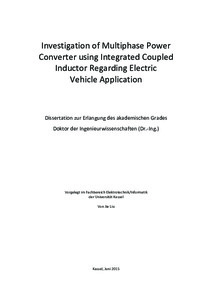| dc.date.accessioned | 2016-05-10T09:05:43Z | |
| dc.date.available | 2016-05-10T09:05:43Z | |
| dc.date.issued | 2016-05-10 | |
| dc.identifier.uri | urn:nbn:de:hebis:34-2016051050282 | |
| dc.identifier.uri | http://hdl.handle.net/123456789/2016051050282 | |
| dc.description.sponsorship | This work was sponsored
by an European project called PV-MIPS project (European commission contract No:
TREN/04/FP6EN/S07.34959/503123) and project W-charge (Wireless Charge) which
is founded by Bundesministerium fuer Umwelt, Naturschutz und Reaktorsicherheit and
cooperated with Audi, VAHLE and Volkswagen. | eng |
| dc.language.iso | eng | |
| dc.rights | Urheberrechtlich geschützt | |
| dc.rights.uri | https://rightsstatements.org/page/InC/1.0/ | |
| dc.subject | Electric Vehicle | eng |
| dc.subject | Multiphase Power Converter | eng |
| dc.subject | Coupled Inductor | eng |
| dc.subject | Power Electronics | eng |
| dc.subject | Tapped-Inductor | eng |
| dc.subject | Control Strategy | eng |
| dc.subject.ddc | 620 | |
| dc.title | Investigation of Multiphase Power Converter using Integrated Coupled Inductor Regarding Electric Vehicle Application | eng |
| dc.type | Dissertation | |
| dcterms.abstract | The challenge of reducing carbon emission and achieving emission target until 2050, has become a key development strategy of energy distribution for each country. The automotive industries, as the important portion of implementing energy requirements, are making some related researches to meet energy requirements and customer requirements. For modern energy requirements, it should be clean, green and renewable. For customer requirements, it should be economic, reliable and long life time. Regarding increasing requirements on the market and enlarged customer quantity, EVs and PHEV are more and more important for automotive manufactures. Normally for EVs and PHEV there are two important key parts, which are battery package and power electronics composing of critical components. A rechargeable battery is a quite important element for achieving cost competitiveness, which is mainly used to story energy and provide continue energy to drive an electric motor. In order to recharge battery and drive the electric motor, power electronics group is an essential bridge to convert different energy types for both of them.
In modern power electronics there are many different topologies such as non-isolated and isolated power converters which can be used to implement for charging battery. One of most used converter topology is multiphase interleaved power converter, pri-marily due to its prominent advantages, which is frequently employed to obtain optimal dynamic response, high effciency and compact converter size. Concerning its usage, many detailed investigations regarding topology, control strategy and devices have
been done.
In this thesis, the core research is to investigate some branched contents in term of issues analysis and optimization approaches of building magnetic component. This work starts with an introduction of reasons of developing EVs and PEHV and an overview of different possible topologies regarding specific application requirements. Because of less components, high reliability, high effciency and also no special safety requirement, non-isolated multiphase interleaved converter is selected as the basic research topology of founded W-charge project for investigating its advantages and potential branches on using optimized magnetic components. Following, all those proposed aspects and approaches are investigated and analyzed in details in order to verify constrains and advantages through using integrated coupled inductors. Furthermore, digital controller concept and a novel tapped-inductor topology is proposed for multiphase power converter and electric vehicle application. | eng |
| dcterms.accessRights | open access | |
| dcterms.creator | Liu, Jie | |
| dc.contributor.corporatename | Kassel, Universität Kassel, Fachbereich Elektrotechnik / Informatik | |
| dc.contributor.referee | Zacharias, Peter (Prof. Dr.-Ing. habil.) | |
| dc.contributor.referee | Brabetz, Ludwig (Prof. Dr.) | |
| dc.date.examination | 2015-06-03 | |

